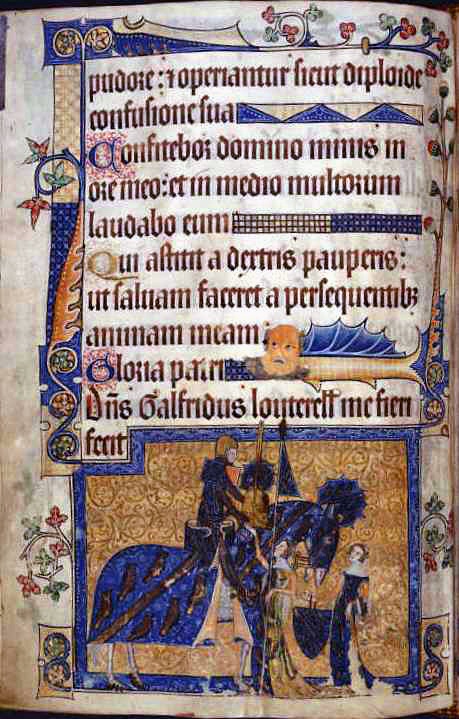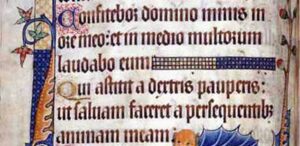The Luttrell Psalter: Knighthood, Hospitality and Piety / Sir Geoffrey Luttrell in His Psalter
- Elaine Harrington
- January 16, 2019
Student Exhibition, MA in Medieval History

Sir Geoffrey Luttrell in His Psalter
Sir Geoffrey Luttrell (1276-1345), who gives the Psalter its name, is represented as a knight between Psalms 108 and 109, on folio 202v. Geoffrey fought in the Welsh and Scottish wars of Edward I (1272-1307) and his son Edward II (1307-1327). In 1297, at the age of twenty one, Geoffrey inherited Irnham Estate in Lincolnshire, where he was the baron until his death in 1345.
In the image, Geoffrey sits on horseback fully armoured, as if in preparation for battle. In medieval times fighting on horseback was a privilege of knighthood. Here the horse is in full decorative caparison emblazoned with the six martlets of the Luttrell crest that emphasise the Luttrell’s noble status. A martlet is a heraldic image of a bird resembling a martin.
This portrait is the largest miniature in the entire manuscript, and it is not only eye-catching due to its vibrant colour scheme but is also full of meaning that relates to Geoffrey’s social status and piety. Above the miniature runs the inscription: Dominus Galfridus Louterell me fieri fecit / ‘Lord Geoffrey Luttrell caused me to be made’ that identifies Geoffrey as the book’s patron.
Sir Geoffrey dominates the image. Even though his figure towers above the two women depicted in the miniature, their presence and attire reinforce the women’s role in preserving dynastic continuity. The two women are his wife, Agnes Sutton and his daughter-in-law, Beatrice Le Scrope. Agnes Sutton hands Geoffrey his helmet. Her dress shows her family’s symbol, a rampant lion whose silhouette is distorted to fit the length of the dress. Beatrice Le Scrope holds Geoffrey’s shield. Significantly, her dress bears the Luttrell coat-of-arms, rather than her own family’s crest. As the wife of Geoffrey’s only surviving son, Beatrice represents the continuation and the future of the Luttrell line emphasised by the presence of martlets on her clothing. Altogether, the representation of Sir Geoffrey and the two women promotes the aristocratic connections he forged.
The miniature does not aim at the realistic portrayal of the family. Geoffrey is presented idealistically, as a knight in the prime of his life. In reality, by the time his daughter-in-law had reached adulthood, he himself would have been quite elderly. In this image, we see Sir Geoffrey Luttrell as a successful knight and the head of a noble family with strong marital connections making for a bright dynastic future.

Psalm 108
The portrait of Sir Geoffrey on horseback acts as a dedication page, yet it is not placed at the opening of the manuscript but on folio 202v. The dedication page with the patron is set below the final words of Psalm 108 that read: Confitebor Domino nimis in ore meo et in medio multorum laudabo eum. Quia adstetit a dextris pauperis ut salvam faceret a persequentibus animam meam / ‘I will give great thanks to the Lord with my mouth: and in the midst of many I will praise him. Because he hath stood at the right hand of the poor, to save my soul from persecutors’ (Psalm 108:30-31). The words of the Psalm convey a sense of gratitude and are a fitting expression of Geoffrey’s appreciation for his life’s achievements through God’s grace. The overall image and its position in the manuscript present Geoffrey as the ideal knight, who combines military prowess with religious devotion.
Psalm 109
If we look across to the facing folio 203r, we see a historiated initial ‘D’ which encloses an image of Christ and King David. The letter ‘D’ for dixit / ‘said’ opens Psalm 109. This was the first text of Sunday Vespers, meaning the evening prayer service of the Church. The figures of King David and Christ illustrate the beginning of Psalm 109: Dixit Dominus Domino meo sede a dextris meis donec ponam inimicos tuos scabellum pedum tuorum. Virgam virtutis tuae emittet Dominus ex Sion dominare in medio inimicorum tuorum / ‘The Lord said to my Lord: Sit thou at my right hand until I make thy enemies thy footstool. The Lord will send forth the sceptre of thy power out of Sion; rule thou in the midst of thy enemies’ (Psalm 109:1-2). King David is promised victory against his enemies by the Lord. He sits at Christ’s right hand side crowned and holding a golden sceptre. Christ is shown with a halo marked with the sign of the cross and holding a globe of the world in his left hand.
If this image and text are examined in the context of Geoffrey’s portrait on the opposite page, the two folios seem to take on a contemporary significance. Michelle P. Brown suggests that the representation of David can double as Edward I, the English king under whom Geoffrey served in the late thirteenth and early fourteenth centuries. If Christ promises to subdue enemies of Edward, Geoffrey then poses as a willing and loyal soldier supporting his king. Geoffrey is shown as being ready for battle to serve his king and God, as he would have done many times throughout his career.
The location of Sir Geoffrey’s portrait in the lower section of folio 202v is well conceived. He is lower ranking than his king, yet he is a proud nobleman. The connection between the two facing folios is further emphasised by the presence of heraldic themes: the five Luttrell martlets are shown in the margin of folio 203r and the six Sutton lions feature at the bottom of this page.
These two images make a powerful statement about the man behind the Luttrell Psalter. Geoffrey Luttrell is a devout person, a brave knight, a royal servant, a generous patron and the head of a noble household.
Liam Costello
Bibliography
Brown, Elizabeth, ‘Use of Heraldry in the Luttrell Psalter’, Genevieve la flechiére de Duram, pp. 123-137, (accessed 13.12.2018).
Brown, Michelle P., The Luttrell Psalter: A Facsimile, London: The British Library, 2006.
Buckland, Rosina, ‘Sounds of the Psalter: Orality and Musical Symbolism in the Luttrell Psalter’, Music in Art, 28, 2003, pp. 71-97.
Coss, Peter R., Keen, Maurice H., Heraldry, Pageantry and Social Display in Medieval England, Martlesham: Boydell & Brewer, 2003.
Emery, Anthony, Greater Medieval Houses of England and Wales, 1300-1500, volume 2: East Anglia, Central England and Wales, Cambridge: Cambridge University Press, 2000.
Freeman Sandler, Lucy, ‘The Word in the Text and the Image in the Margin: The Case of the Luttrell Psalter’, The Journal of the Walters Art Gallery, 54, 1996, pp. 87-99.
Hablot, Laurence, ‘Heraldic Imagery, Definition and Principles’, in Colum Hourihane, ed., The Routledge Companion to Medieval Iconography, London and New York: Routledge, 2016, pp. 386-398, (accessed 13.12.2018).
Latin Vulgate Bible, (accessed 13.12.2018).
